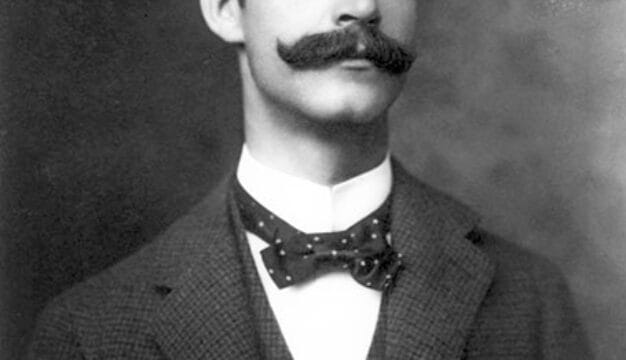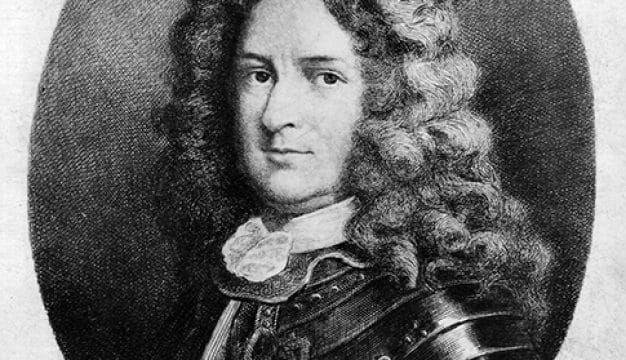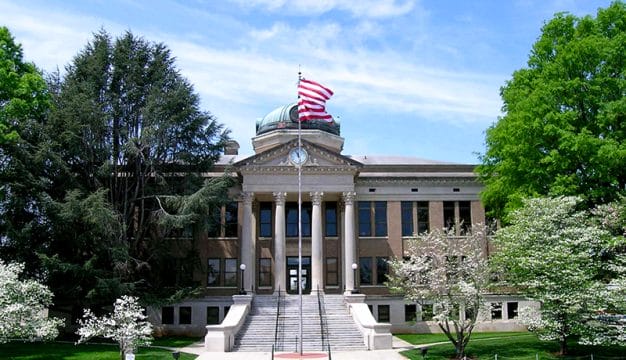Tuskegee Flight Training Program
 Tuskegee Airmen War Bond Poster
In late 1939, after World War II had begun in Europe, Tuskegee Institute in Macon County inaugurated a civilian flight-training program that provided the foundation for the subsequent military aviation training of the famed Tuskegee Airmen. The military program would ultimately train nearly 1,000 pilots in single- and twin-engine aircraft from 1941 to 1946; combat training, for those individuals who qualified, mostly occurred at other bases. Other related ground crew training, of mechanics and armorers for instance, also took place in other locations.
Tuskegee Airmen War Bond Poster
In late 1939, after World War II had begun in Europe, Tuskegee Institute in Macon County inaugurated a civilian flight-training program that provided the foundation for the subsequent military aviation training of the famed Tuskegee Airmen. The military program would ultimately train nearly 1,000 pilots in single- and twin-engine aircraft from 1941 to 1946; combat training, for those individuals who qualified, mostly occurred at other bases. Other related ground crew training, of mechanics and armorers for instance, also took place in other locations.
In the first phase of the civilian program, students learned the rudiments of flying, and those who continued on to subsequent phases learned advanced techniques such as instrument flying and cross-country navigation. In the military program, the students were trained as officers and qualified as military pilots in military training aircraft; they were then ready to learn to fly combat aircraft. After they completed training in operational aircraft, typically at bases beyond Tuskegee, they were ready for combat duty overseas.
Civilian Flight Training for African Americans Established
A national aviation training effort, known as the Civilian Pilot Training Program (CPTP), was launched in 1939 with funding from the federal government via the Civil Aeronautics Authority (CAA). The CAA would provide funding to colleges and universities to recruit students, conduct ground training, and form partnerships with local flight services for the flight training. The purpose of the CPTP was to provide introductory aviation training to thousands of college students; Tuskegee Institute was one of six historically black colleges to participate in the program. The other schools were Howard University, Hampton Institute (now Hampton University), Delaware State College (now Delaware State University), North Carolina A&T, and West Virginia State College (now West Virginia State University).
Although the CPTP offered only civilian flight training, it had an underlying military purpose. The onset of war in Europe in September 1939 accelerated planning for military expansion in the United States, and CAA administrators asserted that the program would create a reservoir of young pilots and enable the military to expand the nation’s air arm.
Tuskegee administrator George L. Washington realized that the CPTP initiative could provide the basis for finally establishing an aviation program at Tuskegee, and he played a pivotal role by facilitating acceptance of Tuskegee’s application, establishing the program, and then managing it throughout World War II. In addition, Washington recruited two engineering professors, B. M. Cornell and Robert G. Pitts, from nearby Alabama Polytechnic Institute (now Auburn University) to provide ground training for the first class. Tuskegee began its first CPTP class in late 1939, with 20 students: 18 men and two women.
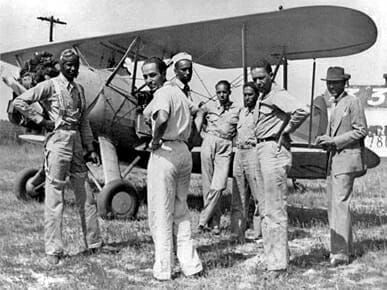 Tuskegee Civilian Pilot Training
The flight training was conducted in Montgomery by Joseph Wren Allen, a white pilot who operated a flight service at the municipal airport there. Although the 40-mile trip to Montgomery was inconvenient, 19 of the 20 students in Tuskegee’s completed the flight training to become licensed private pilots. By spring 1940, Tuskegee had leased and improved a local airstrip, purchased several airplanes, hired its own instructor pilots, and was conducting CPTP training on its own. The institute took advantage of an expansion of CPTP into more advanced flight training—known as the “secondary program”—by purchasing additional aircraft and hiring Charles Alfred “Chief” Anderson, as the chief instructor pilot. A native of Pennsylvania, Anderson was the only African American at the time with a transport pilot license. The move into secondary training attracted African Americans who had completed their initial CPTP courses elsewhere to Tuskegee for additional civilian flight training.
Tuskegee Civilian Pilot Training
The flight training was conducted in Montgomery by Joseph Wren Allen, a white pilot who operated a flight service at the municipal airport there. Although the 40-mile trip to Montgomery was inconvenient, 19 of the 20 students in Tuskegee’s completed the flight training to become licensed private pilots. By spring 1940, Tuskegee had leased and improved a local airstrip, purchased several airplanes, hired its own instructor pilots, and was conducting CPTP training on its own. The institute took advantage of an expansion of CPTP into more advanced flight training—known as the “secondary program”—by purchasing additional aircraft and hiring Charles Alfred “Chief” Anderson, as the chief instructor pilot. A native of Pennsylvania, Anderson was the only African American at the time with a transport pilot license. The move into secondary training attracted African Americans who had completed their initial CPTP courses elsewhere to Tuskegee for additional civilian flight training.
CPTP courses at Tuskegee and the other black colleges substantially increased the number of civilian African American pilots nationwide, but blacks remained barred from aviation duty in the military. With war preparations underway and the prospect of a draft looming, African American activists, led by the black press and the National Association for the Advancement of Colored People (NAACP), had been lobbying aggressively for full participation in the nation’s armed forces. Military aviation was a critical element in this campaign. The activists responded to whites who suggested that blacks lacked the aptitude for participation in the highly technical and prestigious air arm by pointing to the success of black students in the CPTP. As a result of the pressure campaign, the Selective Service Act of 1940, which established the nation’s first peacetime draft, prohibited racial restrictions on voluntary enlistments in any branch of the armed forces. This provision provided a legal basis for challenging the War Department’s policy of excluding blacks from aviation duty, and at least one civil rights organization, the NAACP, initiated a lawsuit to force the admission of African Americans into the U.S. Army Air Corps, the predecessor of the U.S. Army Air Forces (AAF) that was established in June 1941. Consequently, by late 1940, plans were underway in the War Department to establish one segregated flying unit. On January 16, 1941, the War Department announced that the Air Corps would organize and train a black unit—designated the 99th Pursuit Squadron (re-designated the 99th Fighter Squadron in May 1942)—and base it at a new military airfield to be constructed near Tuskegee.
Establishing Military Flight Training at Tuskegee
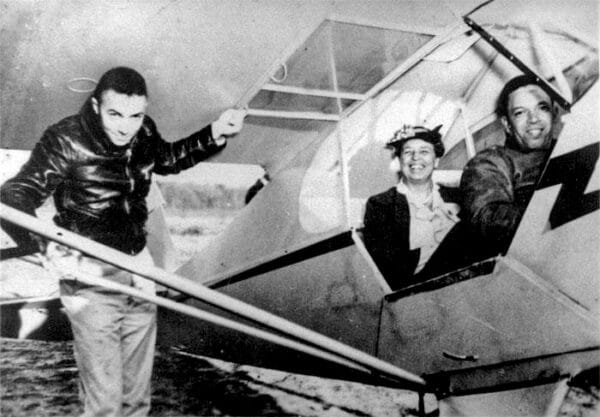 Eleanor Roosevelt and Charles Anderson
During the first half of 1941, the Air Corps began developing the training program for pilots and ground crews of the 99th and building Tuskegee Army Air Field (TAAF) in Macon County. Following standard procedures, a civilian contractor would conduct the first phase of AAF flight training—known as “primary.” The training program received additional publicity in March 1941: First Lady Eleanor Roosevelt, on campus for a meeting of the board of the Rosenwald Foundation, made a flight with Chief Anderson, and a photograph of the pair appeared in newspapers across the country. In June, the War Department awarded a contract for primary flight training to Tuskegee, enabling the school to substantially expand its aviation program, hire more civilian instructors, and construct its own civilian airfield, which was dedicated as Moton Field in 1943 in memory of Tuskegee’s second president, Robert Russa Moton. By the middle of 1941, ground crews for the new squadron were training in Illinois at Chanute Field, an AAF facility. Because the 99th was to be an all-black unit, a full complement of ground support personnel had to be trained, including mechanics, welders, armorers, meteorologists, supply clerks, and parachute riggers.
Eleanor Roosevelt and Charles Anderson
During the first half of 1941, the Air Corps began developing the training program for pilots and ground crews of the 99th and building Tuskegee Army Air Field (TAAF) in Macon County. Following standard procedures, a civilian contractor would conduct the first phase of AAF flight training—known as “primary.” The training program received additional publicity in March 1941: First Lady Eleanor Roosevelt, on campus for a meeting of the board of the Rosenwald Foundation, made a flight with Chief Anderson, and a photograph of the pair appeared in newspapers across the country. In June, the War Department awarded a contract for primary flight training to Tuskegee, enabling the school to substantially expand its aviation program, hire more civilian instructors, and construct its own civilian airfield, which was dedicated as Moton Field in 1943 in memory of Tuskegee’s second president, Robert Russa Moton. By the middle of 1941, ground crews for the new squadron were training in Illinois at Chanute Field, an AAF facility. Because the 99th was to be an all-black unit, a full complement of ground support personnel had to be trained, including mechanics, welders, armorers, meteorologists, supply clerks, and parachute riggers.
The first class of cadets transferred from Moton Field to TAAF for the second phase of their flight training in early November 1941. One month later, the December 7, 1941, attack on Pearl Harbor brought the United States into World War II. In the wake of the attack, the expansion of the nation’s armed forces accelerated. In January 1942, the War Department announced plans to establish a second segregated aviation unit, the 100th Pursuit Squadron, which was re-designated the 100th Fighter Squadron in May 1942. Consequently, the pace and size of the flight training program at Tuskegee began to expand. By the end of 1942, the War Department activated two additional segregated squadrons at TAAF, the 301st and 302nd Fighter Squadrons. These three segregated squadrons were organized into the newly activated 332nd Fighter Group, the first all-black group in the AAF. (In 1944, the 99th Fighter Squadron was assigned to the 332nd as well.)
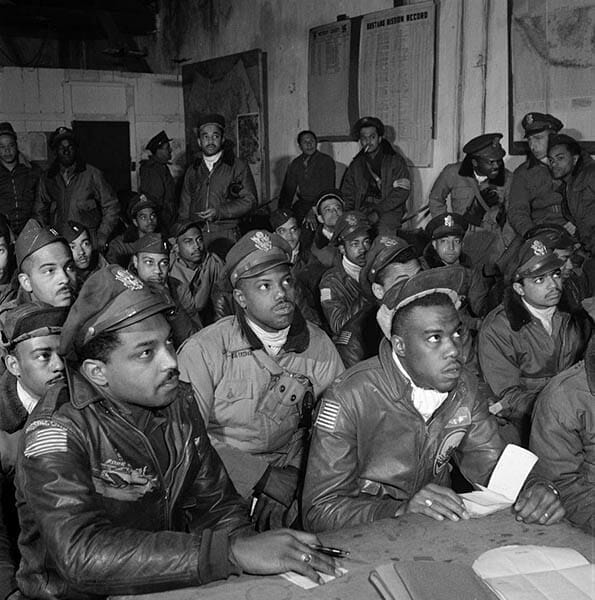 Tuskegee Airmen Being Briefed
The first class of Tuskegee pilots graduated from TAAF on March 7, 1942. As a result of the expansion of the program and delays in moving the fighter units to other bases, by 1943, flight operations at TAAF had become intense and crowded. Numerous aircraft of varying performance characteristics were flying at TAAF, and sequencing the various aircraft competing for takeoff and landing practice reduced training efficiency. That situation prompted criticism of the segregated program from various quarters. Disapproval within the War Department came from William H. Hastie, an attorney and former federal judge who had been appointed as a civilian aide to advise the Secretary of War on racial matters. A former NAACP attorney and opponent of segregation, Hastie had urged the War Department to abandon its plans for segregated training even before the formation of the 99th was announced. As an official in the department, however, Hastie refrained from public criticism but expressed his reservations internally until he resigned in protest in January 1943. He subsequently published his critique of the Tuskegee program in a pamphlet, On Clipped Wings, a few months after he resigned.
Tuskegee Airmen Being Briefed
The first class of Tuskegee pilots graduated from TAAF on March 7, 1942. As a result of the expansion of the program and delays in moving the fighter units to other bases, by 1943, flight operations at TAAF had become intense and crowded. Numerous aircraft of varying performance characteristics were flying at TAAF, and sequencing the various aircraft competing for takeoff and landing practice reduced training efficiency. That situation prompted criticism of the segregated program from various quarters. Disapproval within the War Department came from William H. Hastie, an attorney and former federal judge who had been appointed as a civilian aide to advise the Secretary of War on racial matters. A former NAACP attorney and opponent of segregation, Hastie had urged the War Department to abandon its plans for segregated training even before the formation of the 99th was announced. As an official in the department, however, Hastie refrained from public criticism but expressed his reservations internally until he resigned in protest in January 1943. He subsequently published his critique of the Tuskegee program in a pamphlet, On Clipped Wings, a few months after he resigned.
Hastie’s resignation brought the Tuskegee program under intense scrutiny by the black press and civil rights organizations, in particular because of overcrowding and delays in deploying the 99th overseas for combat duty. In early April 1943, however, the 332nd Fighter Group was reassigned to Selfridge Field in Michigan to prepare for combat and deployment overseas. A few days later, the 99th departed Tuskegee to support Allied operations in North Africa. Those departures eased overcrowding and meant that TAAF could be devoted exclusively to one mission, initial pilot training. But even that mission continued to expand as twin-engine training was added in anticipation of creating a segregated bombardment unit, and black liaison pilots were trained as aerial spotters with black Army artillery units. The decision to establish a segregated bombardment group, and the need to train replacement pilots for the fighter units, meant that pilot training operations at Tuskegee continued at a substantial pace.
By the end of April 1943, the 99th had arrived in North Africa and flew its first combat mission on June 2. Meanwhile, the 332nd prepared for movement overseas at Selfridge and Oscoda fields in Michigan and Walterboro Army Air Field in South Carolina, and it departed the United States for combat duty in Italy in January 1944. For the remainder of the war, the Walterboro field continued to further prepare pilots who had completed their initial training at TAAF for combat duty with the black fighter units overseas.
In early 1944, the 477th Bombardment Group was activated at Selfridge Field with B-25 aircraft and began receiving graduates of the twin-engine program from TAAF. Unlike the single-seat fighters flown by the 99th and the 332nd, the B-25’s crew complement included two pilots as well as a navigator, a bombardier, and gunners. TAAF’s resources were stretched to the limit to provide enough pilot graduates for the both the overseas fighter squadrons and the new bombardment units. Consequently, the non-pilot B-25 crewmembers (navigators and bombardiers) received their initial flight training at various bases in Texas, New Mexico, and California.
After the War
 Moton Field
By the end of the war in September 1945, the AAF’s initial plan for training one segregated flying unit at Tuskegee had expanded to include a fighter group with four squadrons and a bombardment group with three squadrons. This steady expansion of the segregated program eventually made it untenable to restrict all African American flight training operations to Tuskegee. TAAF graduated its last class of pilot trainees in June 1946, and the base was closed, bringing military flying operations at Tuskegee to an end. Shortly after it closed, TAAF was reopened as Sharpe Field, a private airport that operated until perhaps the 1960s. By the early 1990s, Sharpe Field was no longer active, and the site remains in private hands. Tuskegee Institute continued civilian flying operations at Moton Field on a limited basis for several years, and the facility is still an active airport today. In 1998, as a result of federal legislation sponsored by then-Rep. Bob Riley of Alabama, Moton Field was designated the Tuskegee Airmen National Historic Site. In October 2008, the National Park Service officially opened the site’s interactive museum on the Tuskegee Airmen to the public.
Moton Field
By the end of the war in September 1945, the AAF’s initial plan for training one segregated flying unit at Tuskegee had expanded to include a fighter group with four squadrons and a bombardment group with three squadrons. This steady expansion of the segregated program eventually made it untenable to restrict all African American flight training operations to Tuskegee. TAAF graduated its last class of pilot trainees in June 1946, and the base was closed, bringing military flying operations at Tuskegee to an end. Shortly after it closed, TAAF was reopened as Sharpe Field, a private airport that operated until perhaps the 1960s. By the early 1990s, Sharpe Field was no longer active, and the site remains in private hands. Tuskegee Institute continued civilian flying operations at Moton Field on a limited basis for several years, and the facility is still an active airport today. In 1998, as a result of federal legislation sponsored by then-Rep. Bob Riley of Alabama, Moton Field was designated the Tuskegee Airmen National Historic Site. In October 2008, the National Park Service officially opened the site’s interactive museum on the Tuskegee Airmen to the public.
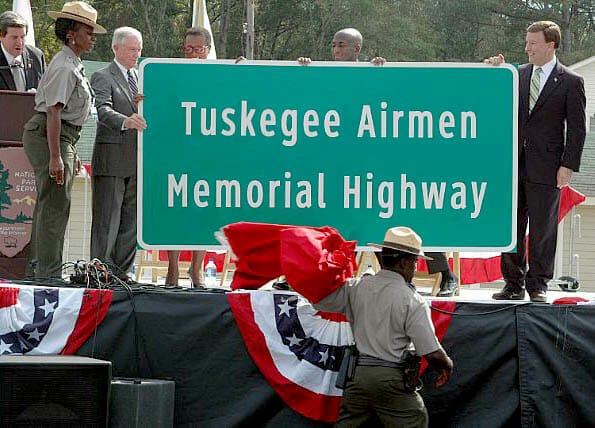 Tuskegee Airmen Memorial Highway Dedication
As a consequence of the post-war demobilization, many of the Tuskegee Airmen left military service. Nevertheless, the AAF continued to maintain one segregated combat group, first at Godman Field in Kentucky and then at Lockborne Army Air Base in Ohio. In response to Pres. Harry Truman’s 1948 executive order that ended segregation in the military, the 332nd Fighter Group was deactivated in 1949, and its members were assigned to other units. The era of segregated military aviation had ended, but its connection with Alabama persists in the name its participants have taken for themselves—the Tuskegee Airmen. The term was the title of Charles Francis’s book, published in the 1950s, but came into general use after the establishment of the veterans’ organization, Tuskegee Airmen, Inc., in 1973.
Tuskegee Airmen Memorial Highway Dedication
As a consequence of the post-war demobilization, many of the Tuskegee Airmen left military service. Nevertheless, the AAF continued to maintain one segregated combat group, first at Godman Field in Kentucky and then at Lockborne Army Air Base in Ohio. In response to Pres. Harry Truman’s 1948 executive order that ended segregation in the military, the 332nd Fighter Group was deactivated in 1949, and its members were assigned to other units. The era of segregated military aviation had ended, but its connection with Alabama persists in the name its participants have taken for themselves—the Tuskegee Airmen. The term was the title of Charles Francis’s book, published in the 1950s, but came into general use after the establishment of the veterans’ organization, Tuskegee Airmen, Inc., in 1973.
